The AMD Radeon RX 590 Review, feat. XFX & PowerColor: Polaris Returns (Again)
by Nate Oh on November 15, 2018 9:00 AM EST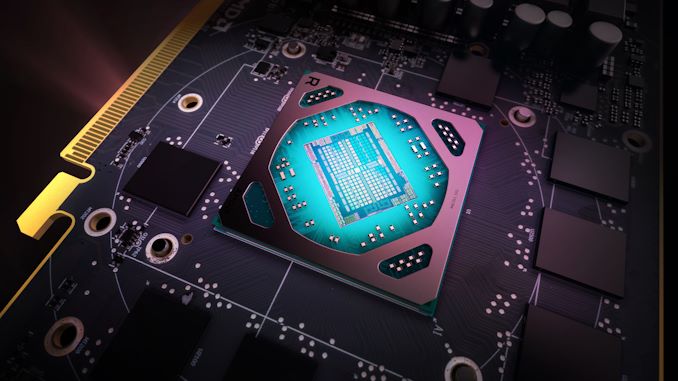
When AMD launched the Polaris-based Radeon RX 480 in June 2016, the focus was firmly on the mainstream market, looking to offer superior value over raw performance. At the same time, AMD also sought to improve their power efficiency by leveraging both microarchitectural changes and their first generation of FinFET GPUs.
Ultimately, this straightforward approach was somewhat derailed by the recent cryptocurrency mining craze, but Polaris has carried on, with bits and pieces appearing in consoles (Xbox One X and PS4 Pro) as well as an early 2017 refresh in the form of the RX 500 series. Launching today is the latest entry with new top offering in the RX 500 series: the AMD Radeon RX 590.
| AMD Radeon RX Series Specification Comparison | ||||||
| AMD Radeon RX 590 | AMD Radeon RX 580 (8GB) | AMD Radeon RX 480 (8GB) | AMD Radeon RX 470 | |||
| Stream Processors | 2304 (36 CUs) |
2304 (36 CUs) |
2304 (36 CUs) |
2048 (32 CUs) |
||
| Texture Units | 144 | 144 | 144 | 128 | ||
| ROPs | 32 | 32 | 32 | 32 | ||
| Base Clock | 1469MHz | 1257MHz | 1120MHz | 926MHz | ||
| Boost Clock | 1545MHz | 1340MHz | 1266MHz | 1206MHz | ||
| Memory Clock | 8 Gbps GDDR5 | 8 Gbps GDDR5 | 8 Gbps GDDR5 | 6.6Gbps GDDR5 | ||
| Memory Bus Width | 256-bit | 256-bit | 256-bit | 256-bit | ||
| VRAM | 8GB | 8GB | 8GB | 4GB | ||
| Transistor Count | 5.7B | 5.7B | 5.7B | 5.7B | ||
| Typical Board Power | 225W | 185W | 150W | 120W | ||
| Manufacturing Process | GloFo/Samsung 12nm | GloFo 14nm | GloFo 14nm | GloFo 14nm | ||
| Architecture | GCN 4 | GCN 4 | GCN 4 | GCN 4 | ||
| GPU | Polaris 30 | Polaris 20 | Polaris 10 | Polaris 10 | ||
| Launch Date | 11/15/2018 | 04/18/2017 | 06/29/2016 | 08/04/2016 | ||
| Launch Price | $279 | $229 | $239 | $179 | ||
In short, the RX 590 is another Polaris 10 revision but now built on GlobalFoundries' 12nm process, enabling higher clockspeeds on an increased power budget. In that sense, it is much like the RX 580 refresh and its increased clocks over the RX 480, achieved by spending all the efficiency gains from manufacturing maturity – and then some, given the additional 35W TBP increase. The RX 590 ups the ante with a 225W TBP, 75W over the original RX 480 TBP, and hits RX Vega level clockspeeds with reference 1469MHz/1545MHz clocks.
Naturally, the tradeoffs between power efficiency and raw performance is a classic problem of silicon engineering, and it’s been somewhat of a sticking point for Polaris since the beginning. Even though Polaris improved on efficiency over older GCN products, NVIDIA’s top-to-bottom Pascal series brought its own power and clockspeed improvements. At the original RX 400 series launch, pushing the 150W power budget to its limits led to the single 6pin powered reference RX 480’s issues with power draw from the PCIe slot. So as we noted at the RX 500 launch, instead of fighting an efficiency battle that they can’t win, AMD has opted for raw performance and competing on value.
Otherwise, there aren’t any other architectural changes, and memory bandwidth is unchanged. We’ve already seen that Polaris 10 likes memory bandwidth, but realistically the volume and timing of these RX 590 parts are unlikely to warrant the cost or validation of alternatives (i.e. 9 Gbps GDDR5), especially considering the recent memory supply crunch. As for the 12nm process itself, AMD isn’t disclosing much, but given development costs it’s likely a straight port of the 14nm design with 9T transistor libraries, much like Zen+. With an identical die size and transistor count to Polaris 10, the silicon layout is presumably like Zen+ as discussed by Ian earlier this year; additional dark silicon that can now act as a thermal buffer between features. Or in other words, lowering potential thermal limitations to enable higher clocks, something that's no easy feat given that Polaris wasn't originally designed to clock quite this high.
Polaris in the Year 2018
On that note, GlobalFoundries’ 12LP has been available for most of last year, and we’ve already seen it in action with Ryzen 2000 and Threadripper 2. And “Vega 14nm+” was indeed listed on AMD’s roadmap in mid-2017 though no longer present by the time of CES 2018. So why is AMD doing this now, on the cusp of 2019? AMD’s line is that given limited capacity and time-to-market considerations, this was the timeframe for the RX 590 to happen.
Unpacking this a little bit, when we take capacity at face value, the Ryzen 2000 family (which includes Raven Ridge) is considerably higher volume compared to one graphics SKU and carries much more market impact, which factors into resources for both fabbing and productizing the RX 590. In any case, being pin-compatible with Polaris 10, Polaris 30 allows board partners to quickly integrate the GPU into existing high-end RX 580 board designs. Meanwhile the story behind Vega 12nm (as with other Vega details) is known only to AMD and out-of-scope here, but roughly speaking the obstacles facing RX 590 development would be multiplied with Vega.
We also know the impact of decreasing cryptocurrency mining demand and potential channel congestion, but also of the AIB dynamics that AMD need to consider with GPUs. Seasonally, the first half of the year is flat to down for GPU sales, and today’s launch of course is just in time for the Black Friday and holiday window (though AMD has probably missed most of the OEM window). Not to be forgotten is their erstwhile competitor NVIDIA and the new generation of high-end GeForce RTX cards; hardware launches tend to be best met with some kind of hardware response, even on solely marketing grounds as in this case the RTX 2070 and above compete in a different segment than the RX 590.
The Radeon RX 590 Lineup and Positioning
Like the RX 580, AMD is not shipping a reference design for the RX 590, and four custom models (XFX, PowerColor, Sapphire, and Asus) are available today. At a glance, the AIB cards appear to reuse boards found in factory-overclocked RX 580s, which is expected given the drop-in compatibility of Polaris 30. Meaning, for overbuilt boards that already meet the RX 590 power requirements, then partners can simply put in a Polaris 30 GPU and flash the RX 590 BIOS. Realistically, heavily factory-overclocked RX 580s are not too far off from RX 590's clocks, with boards and thermal solutions built for higher TBPs anyway. For example, the XFX RX 590 Fatboy and PowerColor RX 590 Red Devil are not far from the XFX RX 580 GTS Black Edition OC+ and PowerColor RX 580 Red Devil Golden Sample, both with 1425MHz boost.
To sweeten the deal, AMD is including a launch bundle of three games: Resident Evil 2 (2019), The Division 2, and Devil May Cry 5. Officially, it's called the "Raise the Game Fully Loaded" bundle and brings all three games for qualified RX Vega and RX 590 purchases, and any two of the three for qualified RX 580 purchases. The offer runs until February 9, 2019. In any case, the original three-game “Raise The Game” bundle for RX Vega, RX 580, and RX 570 concluded at the start of the month, so AMD has no other competing promotions on their side. NVIDIA, however, still has their Monster Hunter: World bundle for the GTX 1070 Ti, GTX 1070, and GTX 1060 6GB running until November 29th.
And on the topic of the Pascal-based 1280 core GeForce GTX 1060 6GB, it remains the primary competition for the RX 590. Since its July 2016 launch, the GTX 1060 6GB has been squaring up against Polaris since July 2016, with a mild 2017 refresh in the form of 9Gbps GDDR5 variants. The GeForce RTX 20 series has not offered a direct successor for the GTX 1060 6GB or below, so there’s a potential opening for a modern card in that price/performance space. But AMD is clear in targeting the performance gap between the RX Vega 56 and RX 580 8GB.
Nevertheless, the RX 590 is an iterative product and much like the RX 580 is not intended for current Polaris 10 owners. So AMD is largely trying to court those gaming at 1080p on older mainstream cards like the GTX 970 and R9 380. Or in other words, those due for an upgrade and looking at the $200 to $400 video card market. At an MSRP of $279, the RX 590 is certainly differentiated by price from the RX 580 8GB, which can currently be found for around $200-$210. Meanwhile the GTX 1060 6GB is around $250 at the time of writing. As the third iteration of Polaris 10, the RX 590 will need to ensure a solid lead over both, especially if power consumption hits the roof. We’ll soon find out.
| Fall 2018 GPU Pricing Comparison | |||||
| AMD | Price | NVIDIA | |||
| Radeon RX Vega 56 | $519 | ||||
| $479 | GeForce GTX 1080 | ||||
| $409 | GeForce GTX 1070 Ti | ||||
| $379 | GeForce GTX 1070 | ||||
| Radeon RX 590 | $279 | ||||
| $249 | GeForce GTX 1060 6GB (1280 cores) |
||||
| Radeon RX 580 (8GB) | $200/$209 | GeForce GTX 1060 3GB (1152 cores) |
|||


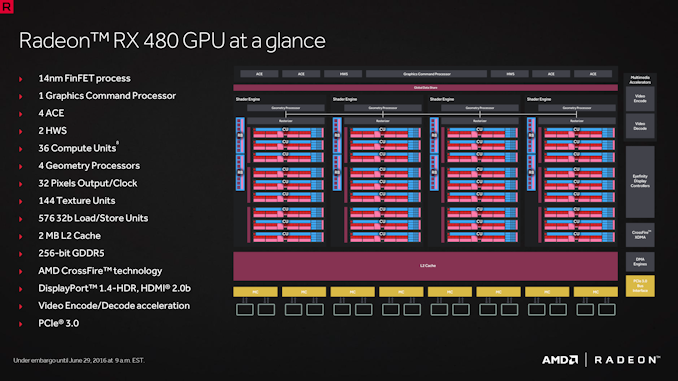
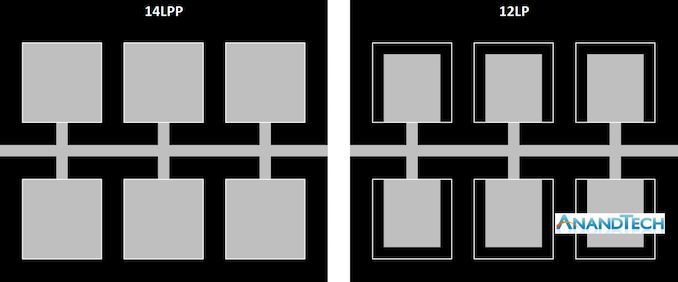
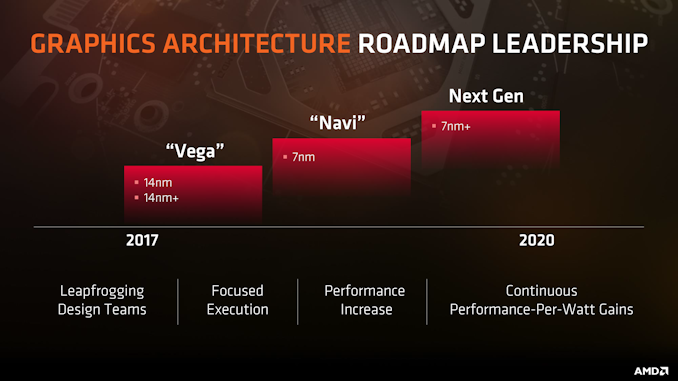
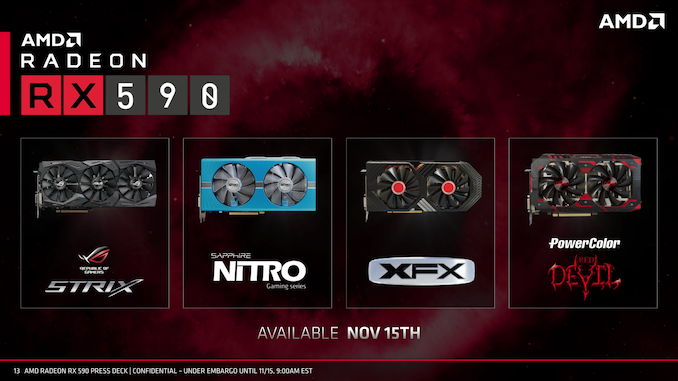
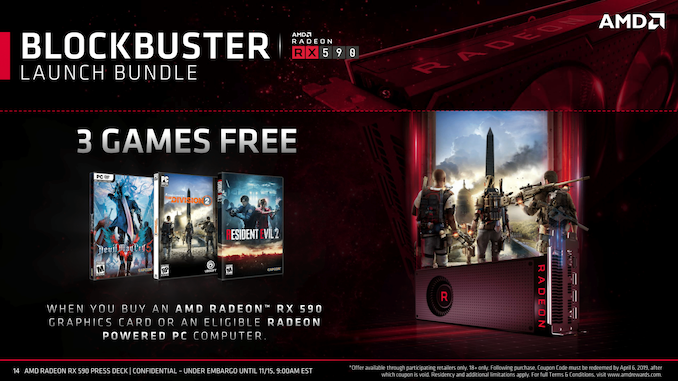
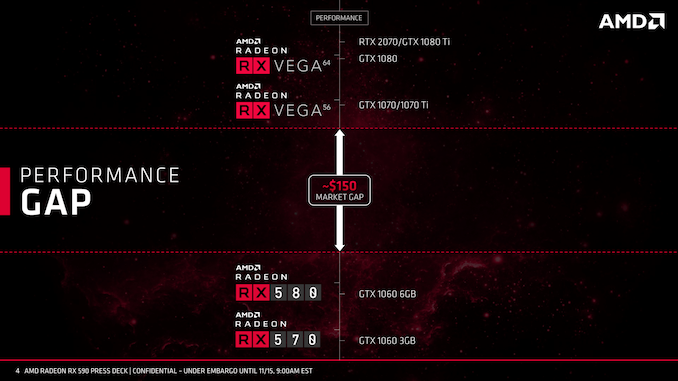








136 Comments
View All Comments
silverblue - Thursday, November 15, 2018 - link
I was talking about the process; I know the 2000 series has done well.I didn't even know TSMC had a 12nm process, but either it's not very well suited to this application or AMD have just clocked it far too highly, so it's not a successful product in that sense.
frenchy_2001 - Thursday, November 15, 2018 - link
Nvidia's Volta and Turing are fabbed on TSMC 12nm.So, it seems to work well for GPUs, but AMD's architecture is just not competitive in their perfs/watt.
silverblue - Thursday, November 15, 2018 - link
I completely forgot about them.It feels like Polaris is bottlenecked in some way, and increasing clock speeds is just a brute force way of alleviating the issue at the cost of significant power consumption. Perhaps the design is just broken to begin with.
Manch - Friday, November 16, 2018 - link
Memory bandwidth is the bottleneck for Polaris.deksman2 - Friday, November 16, 2018 - link
Power consumption - wise, its the process node from GLOFO that's limiting Polaris mainly from achieving high frequencies and low power consumption.GLOFO nodes are designed for low clocks and mobile parts... 12nmLP is designed for the same, and AMD used it for RX 590.
That's why power consumption explodes on high frequencies.
deksman2 - Friday, November 16, 2018 - link
Polaris is bottlenecked by the GLOFO 12nmLP process that's being used here.It's designed for low clocks and mobile parts.
There was NOTHING posted about AMD using TSCM 12nm node for Polaris refresh. TSMC 12nm was slated for Nvidia.
AMD gets to use TSMC 7nm high performance process node for Zen 2, Vega Instinct and Navi.
eek2121 - Saturday, November 17, 2018 - link
"Limited" is the word you want to use to describe Polaris. "Broken" would imply it doesn't work at all. Polaris was never meant to be a high end architecture. They have just been doing refreshes because they are likely reorganizing their GPU division and coming up with a new architecture to replace GCN. Doing something like that takes time, and AMD has to continue generating revenue. Also, the 590 is not a bad card at all, while I have a 1080ti in my machine, I would definitely consider a Polaris card in any new machine I build (for friends, family, etc.)deksman2 - Friday, November 16, 2018 - link
Incorrect on AMD's architecture not being competitive because AMD is still using GLOFO 12nm LP process for RX 590 which is designed for low clocks and mobile parts.TSMC 16nm and 12nm processes are designed for high performance and efficiency... those nodes are superior to GLOFO (that's why AMD's GPU's end up sucking up A LOT of power at high frequencies - its because the process node from GLOFO cannot take it, and partly because the compute performance on Polaris is a lot bigger than on GTX 1060).
porcupineLTD - Thursday, November 15, 2018 - link
I highly doubt that, any source?deksman2 - Friday, November 16, 2018 - link
Actually 'Cooe', you are incorrect.AMD is using 12nmLP process from GLOFO for RX 590.
You can read about that here:
https://www.pcgamesn.com/amd-rx-590-overclocking-p...
Furthermore, the power consumption on RX 590 should be a dead give-away, because this is exactly the same thing that happened for Ryzen+ too (not to mention the fact we had 0 indications that AMD would refresh Polaris on TSMC 12nm process. NV got access to 12nm TSMC process, not AMD... AMD got access to TSMC's 7nm high perf. process and they have reserved Zen 2, Vega Instinct and Navi for that).
They increased the frequencies on 12nmLP, but as a result they also saw an increase in power consumption.
Polaris is clocked WAY beyond the voltage comfort zone on GLOFO processes (which are designed for low clocks and mobile parts).
If they wanted a refresh, they should have just dropped the frequencies down to 580 levels and call it a more power efficient rebrand.
If AMD moved to TSMC 12nm for RX 590, power consumption on this GPU would actually be lower than on GTX 1060 with those frequencies.